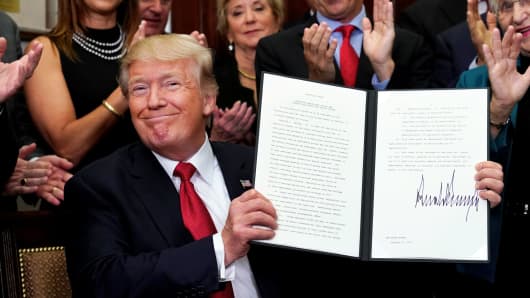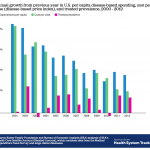
A year after being elected president, Donald Trump still has failed to achieve the first major health-care policy goal he set for himself — although he has taken several steps toward undercutting his predecessor’s big health law.
Trump on his very first day in office signed an executive order aimed at “minimizing the economic burden of Obamacare.”
That same order said “it is the policy of my Administration to seek the prompt repeal” of the Affordable Care Act, as Obamacare is formally known.
Trump has railed for years against the ACA, calling it a bad law that Americans were “suffering” under.
But he didn’t win repeal of the law, despite his fellow Republicans having control of both chambers of Congress.
That failure has left Trump without a major legislative victory so far in his first year in office, and also has exposed fault lines in the Senate, which could lead to his desire for a major tax reform bill falling short.
However, Trump has continued chipping away at the ACA through a series of executive and administrative actions, infuriating defenders of the law.
Within days of taking office, the Trump administration killed media ads designed to encourage people to sign up for Obamacare plans in the final days of open enrollment in that coverage for 2017.
The administration’s move was blamed for Obamacare plans experiencing a decline in the number of sign-ups for the first time.
The president and the Department of Health and Human Services have also repeatedly bad-mouthed the ACA, which has led to fears that fewer people will sign up for health plans for 2018 because they think the law is no longer in effect.
“Certainly the president has taken steps to weaken the program,” said Larry Levitt, an Obamacare expert with the Kaiser Family Foundation. “But we don’t know yet exactly what effect it’s had and won’t until the end of the enrollment period.”
Trump’s administration and GOP leaders in the House struggled for two months earlier this year to win approval of a bill that would repeal and replace major parts of Obamacare.
That bill ran into trouble with both conservative members of the House who griped that it did not repeal the ACA outright, and from moderate members who were concerned it would lead to big drops in the number of uninsured Americans.
The legislation also had strikingly high negative ratings from the public, so much so that members of Congress took to actively avoiding town halls and other events where they would be lambasted about the bill.
Finally, in May, the House narrowly passed a repeal-and-replace bill in a party-line vote.
Trump celebrated with House Republicans right after the vote in the Rose Garden at the White House.
“Welcome to the end of Obamacare,” crowed Vice President Mike Pence as he introduced Trump at the event.
Trump himself said, “We’ve come up with a really incredible health-care plan.”
But about a month later, Trump was criticizing that House bill as he met with Republican senators, whose chamber would need to pass their own legislation if Obamacare were to be overturned.
Trump called the House legislation “mean,” and told the senators he wanted them to develop a plan that would be more generous.
GOP leaders in the Senate spent the next month crafting their own legislation that would repeal and replace Obamacare.
But Trump’s hopes for that bill passing were dashed in late July, when three Republicans joined Democrats in voting against the plan, dooming it to failure.
Trump in August angrily urged senators to “get back to work” on a replacement bill, and lashed out at Senate Majority Leader Mitch McConnell, R-Ky., for failing to pass the measure in July.
The president’s hopes were raised again in September with the introduction of a last-ditch Obamacare replacement effort by Sens. Lindsey Graham, R-S.C., and Bill Cassidy, R-La.
That effort died late in the month with Sen. Susan Collins, R-Maine, said she would join two other GOP senators in opposing the bill.
Days later, Trump’s secretary of Health and Human Services, Dr. Tom Price, resigned amid scathing criticism for having taken more than two dozen costly private plane trips instead of cheaper flights while on government business.
Despite the setbacks in Congress, and the loss of Price, Trump powered ahead with decisions that troubled Obamacare supporters.
In August, the administration reduced Obamcare’s advertising budget for the coming enrollment season by 90 percent, and the budget for its in-person enrollment program by more than 40 percent.
On Oct. 12, Trump signed an executive order that the administration said was geared at expanding health-coverage options and reducing costs for millions of Americans.
That order directed federal agencies to explore relaxing the rules surrounding the issuance of different types of health plans.
Obamacare defenders feared the order could eventually lead to an exodus of people from plans sold on Obamacare marketplaces, which in turn could result in higher prices for those plans.
However, a longtime critic of the ACA called Trump’s executive order “pretty hollow,” noting that it only directed agencies to consider new regulations, not to actually implement specific ones.
But hours after signing the order, Trump followed through on a threat that he had made for months. His administration said it would stop paying Obamacare insurers billions of dollars worth of reimbursements for discounts they must offer low-income customers.
Trump’s threats to discontinue those payments had already lead to Obamacare premiums being sharply higher for 2018 plans than they otherwise would have been.
And the Congressional Budget Office has estimated that premiums in 2020 will be 25 percent higher than they otherwise would have been because of Trump’s decision to end the payments.
People who buy Obamacare plans, but who do not qualify for federal subsidies because they earn too much much, will have to pay the higher premium prices.
Levitt, of the Kaiser Family Foundation, said, “The president has successfully creatred chaos in the insurance market.”
He said Trump’s administrative actions “were sometimes put on hold by the drawn-out debate in Congress” on Obamamacare repeal.
“You could argue that the White House is hitting its stride now and seems to be ramping up its efforts to alter the direction of Obamacare,” Levitt said.
But Levitt said that after the results of Tuesday’s elections, which saw Democrats win big victories in Virginia, New Jersey and Maine, “it seems to tough to resurrect” efforts in Congress to have a “sweeping” repeal of Obamacare.
In addition to seeking Obamacare’s repeal this year, Trump has also set his sights on other health-care-related issues, again with mixed results.
In August, Trump said he would declare a “national emergency” for the opioid crisis, which has lead to a sharp upswing in the number of fatal overdoses by Americans on prescription painkillers and heroin.
But in late October, he declared the crisis a “public health emergency,”not a national emergency.
But Trump requested no new federal funding as part of that declaration. If he had declared a national emergency, funds would have been immediately freed up. Aides said Trump would soon request more money for the opioid effort.
Trump has repeatedly attacked drugmakers for high prices of prescription medication. He has said pharmaceutical companies are “getting away with murder.”
But despite such rhetoric, and despite the administration suggesting that Trump would sign an executive order on drug prices, no such action has been forthcoming. The White House did not respond to a request for comment on its plans for action on drug pricing.
Source:-CNBC










